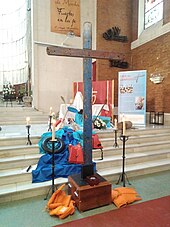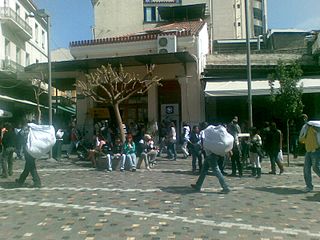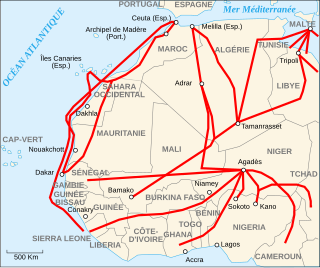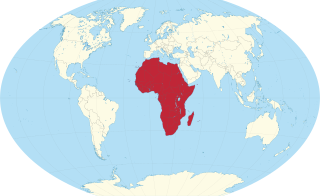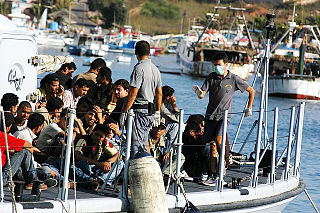Migration flows
Since the 1960s, the main source countries of migration from Africa to Europe have been Morocco, Algeria, Tunisia and to a lesser extent, Egypt. This has resulted in large diasporas with origins in these countries by the end of the 20th century. In the period following the 1973 oil crisis, immigration controls in European states were tightened. The effect of this was not to reduce migration from North Africa but rather to encourage permanent settlement of previously temporary migrants and associated family migration. Much of this migration was from the Maghreb to France, the Netherlands, Belgium and Germany. From the second half of the 1980s, the destination countries for migrants from the Maghreb broadened to include Spain and Italy, as a result of increased demand for low-skilled labour in those countries. [8]
Spain and Italy imposed visa requirements on migrants from the Maghreb in the early 1990s, and the result was an increase in illegal migration across the Mediterranean. Since 2000 sub-Saharan African states. [8]
During 2000–2005, an estimated 440,000 people per year emigrated from Africa, most of them to Europe. [9] According to Hein de Haas, the director of the International Migration Institute at the University of Oxford, public discourse on African migration to Europe portrays the phenomenon as an "exodus", largely composed of illegal migrants, driven by conflict and poverty. He criticises this portrayal, arguing that the illegal migrants are often well educated and able to afford the considerable cost of the journey to Europe. Migration from Africa to Europe, he argues, "is fuelled by a structural demand for cheap migrant labour in informal sectors". Most migrate on their own initiative, rather than being the victims of traffickers. Furthermore, he argues that whereas the media and popular perceptions see irregular migrants as mostly arriving by sea, most actually arrive on tourist visas or with false documentation, or enter via the Spanish enclaves, Ceuta and Melilla. He states that "the majority of irregular African migrants enter Europe legally and subsequently overstay their visas". [8] Similarly, migration expert Stephen Castles argues that "Despite the media hysteria on the growth of African migration to Europe, actual numbers seem quite small – although there is a surprising lack of precision in the data". [10]
According to the Organisation for Economic Co-operation and Development (OECD), migration from African countries to more developed states is small in comparison to overall migration worldwide. The BBC reported in 2007 that the International Organization for Migration estimates that around 4.6 million African migrants live in Europe, but that the Migration Policy Institute estimates that between 7 and 8 million illegal migrants from Africa live in the EU. [11]
Undocumented immigration

Undocumented migration from Africa to Europe is significant. Many people from less developed African countries embark on the dangerous journey for Europe, in hopes of a better life. In parts of Africa, particularly North Africa (Morocco, Mauritania, and Libya), trafficking immigrants to Europe has become more lucrative than drug trafficking. Undocumented migration to Europe often occurs by boat via the Mediterranean Sea, or in some cases by land at the Spanish Enclaves of Ceuta and Melilla, and has made international headlines. Many migrants risk serious injury or death during their journey to Europe and most of those whose asylum requests were unsuccessful are deported back to Africa. [12] [13] Libya is the major departure point for illegal migrants setting off for Europe. [14] [15] However, undocumented African migrants in Europe have not necessarity entered Europe through unauthorized ways. Many of them, have entered with valid visas which they have overstayed. Faced with increased exclusion by European migration policies, many African migrants are left with no option than to enter and reside illegally. As Apostolos Andrikopoulos wrote, in this context of increased hostility and legal exclusion, many African migrants "turn to kinship in search of security, stability, and predictability". [16] Kinship and social relations provide support to unauthorized migrants to deal with the precarity of their legal status.

Between October 2013 and October 2014, the Italian government ran Operation Mare Nostrum, a naval and air operation intended to reduce unauthorized migration to Europe and the incidence of migratory ship wreckages off the coast of Lampedusa. The Italian government ceased the operation as it was judged to be unsustainable, involving a large proportion of the Italian navy. The operation was replaced by a more limited joint EU border protection operation, named Operation Triton managed by the EU border agency, Frontex. Some other European governments, including Britain's, argued that the operations such as Mare Nostrum and Triton serve to provide an "unintended pull factor" encouraging further migration. [17] [18]
In 2014, 170,100 illegal migrants were recorded arriving in Italy by sea (an increase from 42,925 arrivals recorded in 2013), 141,484 of them leaving from Libya. [19] Most of them came from Syria, the Horn of Africa and West Africa. [20] [21]
The issue returned to international headlines with a series of migrant shipwrecks, part of the 2015 Mediterranean migration crisis. The International Organization for Migration (IOM) estimates suggest that between the start of 2015 and the middle of April, 21,000 migrants had reached the Italian coast and 900 migrants had died in the Mediterranean. [22] Critics of European policy towards illegal migration in the Mediterranean argue that the cancellation of Operation Mare Nostrum failed to deter migrants and that its replacement with Triton "created the conditions for the higher death toll". [23]
In September 2023, over 120 boats, carrying roughly 7,000 migrants from Africa—more than the total population of Lampedusa—arrived on the island within the span of 24 hours. [24]
